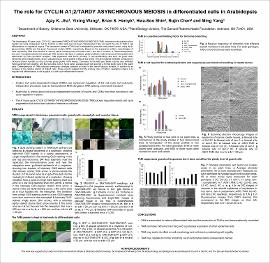| dc.contributor.author | Jha, Ajay K. | |
| dc.contributor.author | Wang, Yixing | |
| dc.contributor.author | Hercyk, Brian S. | |
| dc.contributor.author | Shin, Hwa-Soo | |
| dc.contributor.author | Chen, Rujin | |
| dc.contributor.author | Yang, Ming | |
| dc.date.accessioned | 2023-10-20T15:27:03Z | |
| dc.date.available | 2023-10-20T15:27:03Z | |
| dc.date.issued | 2013-07-20 | |
| dc.identifier | oksd_jha_role_for_cyclin_a1_2013 | |
| dc.identifier.citation | Jha, A., Wang, Y., Hercyk, B., Chen, R., Yang, M. (2013). The role for CYCLIN A1;2/TARDY ASYNCHRONOUS MEIOSIS in differentiated cells in Arabidopsis. | |
| dc.identifier.uri | https://hdl.handle.net/11244/339857 | |
| dc.description.abstract | The Arabidopsis A1-type cyclin, CYCA1;2, also named TARDY ASYNCHRONOUS MEIOSIS (TAM), is known for its positive role in meiotic cell cycle progression, but its function in other cells has not been characterized. Here we report the role of TAM in cell differentiation in vegetative organs. The expression pattern of TAM was investigated by promoter and protein fusions using the β- glucuronidase (GUS) and the green fluorescent protein (GFP), respectively. Based on the expression pattern, morphologies of cells expressing TAM were studied in various plants including loss-of-function tam-1 and tam-2 mutants, a TAM-overexpression line, tam-1 complemented by the wild type TAM, and the wild-type. In addition, ploidy profiles in mature leaves of these plants were determined by flow cytometric analysis. TAM expression was found primarily in non-proliferating cells such as guard cells, trichomes, and mesophyll cells, and in vascular tissue, but its protein is kept at low levels. The tam mutants exhibited a reduction in trichome branch number but had a normal ploidy profile in the leaves. Compared to the wild type, these mutants also exhibited more pavement cell swelling, and the null allele, tam-2, had a larger average guard cell size but a normal ploidy level in the guard cells. Overexpression of TAM produced phenotypic changes opposite to those in the loss-of-function mutants, in addition to an increase in the relative portion of diploid cells. These results suggest that the primary role of TAM in vegetative organs is to regulate cell differentiation or cell turgidity in a cell-cycle-independent manner. | |
| dc.format | application/pdf | |
| dc.rights | This material has been previously published. In the Oklahoma State University Library's institutional repository this version is made available through the open access principles and the terms of agreement/consent between the author(s) and the publisher. The permission policy on the use, reproduction or distribution of the material falls under fair use for educational, scholarship, and research purposes. Contact Digital Resources and Discovery Services at lib-dls@okstate.edu or 405-744-9161 for further information. | |
| dc.title | The role for CYCLIN A1;2/TARDY ASYNCHRONOUS MEIOSIS in differentiated cells in Arabidopsis | |
| dc.date.updated | 2023-10-18T21:04:36Z | |
| osu.filename | oksd_jha_role_for_cyclin_a1_2013.pdf | |
| dc.description.department | Plant Biology, Ecology and Evolution | |
| dc.type.genre | Presentation | |
| dc.type.material | Text | |
| dc.identifier.author | ORCID: 0000-0002-7499-3338 (Yang, Ming) | |
| dc.identifier.author | ScopusID: 57151591400 (Yang, Ming) | |
